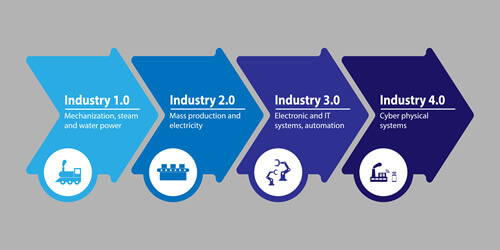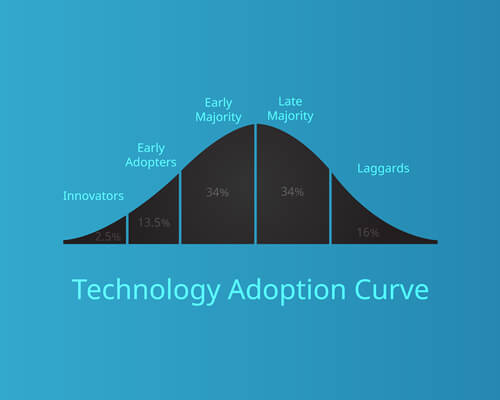Artificial Intelligence - 4th Industrial Revolution
Is AI the fourth Industrial Revolution?
Quite a scary thought – are we witnessing the beginning of the 4th industrial revolution, driven by big data sets that facilitate the development of artificial intelligence? If so, what does this mean and how will AI impact our lives?
Many, particularly marketers, work daily with AI. It is key to managing and maximising performance of the incredibly large and complex data sets driven, for example, by the need to monitor highly intricate paid AdWords campaigns. Artificial Intelligence is also one of the key technologies that has given robotics the biggest boost, through facilitating flexible decisions in real time (source). AI is therefore already impacting the working lives of many, particularly those involved in manufacturing, tech sectors, predictive analysis (Economics and Meteorology) and even content generation, through tools such as ChatGPT.
However, what are the takeaways and lessons to be learned from previous industrial revolutions?
Industrial Revolutions and Lessons from History
When researching timelines of the 2nd and 3rd industrial revolutions they, quite alarmingly, collide with cataclysmic events. For example, the former started in Britain and ran from 1870 to 1914 (source), whereas the latter ran from the 1950s to the 1990s (source), or in other words the 2nd industrial revolution immediately preceded WWI and the 3rd Industrial revolution coincided with the Cold War.
Although an uncomfortable fact, it is well documented that wars drive technological development (source). Furthermore, and quite ironically, particularly when reflecting upon the horror and the waste of life that wars produce, they also lead to innovations that can change everyday life for the better. For example, WWII led to innovations that include the Flu Vaccine, Penicillin, Jet Engines, Blood Plasma Transfusions, Radar, and Electronic Computers (source). Noteworthy is that the latter, namely levels of computing developed in WWII, also laid the foundations for the 3rd industrial revolution (source).

But what lessons can we learn, both strategically and tactically from these hugely destructive episodes, so that we may improve working conditions moving forward? Furthermore, is it even valid to consider these events when using such a lens to draw analogies? This questions the origin of strategy, which as per the Strategic Thinking Institute (source):
‘…originated from the necessity of peoples to defeat their enemies. Without enemies, the need for strategy is non-existent.’
For a comparison to business, simply substitute competitors for enemies in the above quote, which may explain why strategy is taught within leading business schools worldwide and remains the mainstay of C-suite executives. Read an MBA and one of the first things you will cover within respective modules are the origins of it; warfare. A topic quickly followed by an array of academic models designed to guide successful strategic thinking.
However, as opposed to revisiting academia, lets instead peer through the lens of real-life and learn through drawing analogies to hard fought battles. We may therefore discover new insights and gain a deeper understanding of how technology, both through adoption and lack of adoption, has influenced historic events and led to respective outcomes. In doing so, we may also be able to improve current working practices and procedures, by comparing and contrasting to previous events, so that we begin to recognise respective drivers and put the lessons of history to good use.
Industrial Revolutions and the Impact of Technological Development
WWI was characterised by trench warfare (source). However, the increased use of tanks by the Allies, a technological development facilitated by the 2nd industrial revolution, led to the end of trench warfare in 1918 (source). It also steered an Englishman, Sir Basil Liddell Hart, towards developing a theory for a new type of war (source). Recognising the changing technological landscape, Liddell Hart advocated using the signalling core to provide information flow for the tight coordination of air and ground forces, through good radio communications. The latter was a recent technological development, which made this form of warfare possible for the first time in history.
Liddell Hart’s efforts to mechanize the Army with tank and anti-aircraft forces were resisted by most professional officers and his writings became much more influential in Germany than in France or his native England. To sum up, the Allies handed a strategic competitive advantage to a potential enemy for any upcoming future conflict through what may be viewed as a lack of technology adoption. Also noteworthy, is that the Germans improved Liddell Hart’s theory in two key areas, they developed the Stuka for ground attack and deployed Enigma to secure battlefield communications. As for the outcome, this became the basis of lightning war, or Blitzkrieg, through which German armies completely overwhelmed the Allies and rapidly mastered the European Continent from 1939 (source).
Strategic Analogy to the Modern Organisation
An article published by Prahalad and Hamel in the Harvard Business Review, Core Competencies of the Organisation, notes that the most powerful way to prevail in global competition remains invisible to many companies. As for core competencies, Prahalad and Hamel advocate coordination and integration of multiple streams of technologies, which underpin the ability to develop successful strategies for growth (source). Furthermore, some view communication as constituting an organisation (source), which also requires the ability to integrate multiple streams of technology to support effective communication channels.
There is nothing particularly new here, as we can see these elements at play within the theory developed by Liddell Hart around 60 years prior to the publication of this article. In particular, the use of technology adoption (mechanization) to develop new strategies, which at a tactical level were supported by highly effective communication channels (radio communications encoded by Enigma for security). Furthermore, history, through analogy, has provided a vivid demonstration of the effectiveness of respective forces at work within the most competitive of theatres, including how the ‘most powerful way to prevail remained invisible’ to English and French forces.
It may even be argued that Liddell Hart’s theory, through the dire need of the Allies to unpick its effectiveness, laid the foundations for the 3rd industrial revolution, which is commonly referred to as ‘The Digital Revolution’ (source). Work at Bletchley Park to crack the Enigma code facilitated development of early computing devices, more specifically The Turing-Welchman Bombe (source), followed by Colossus, which is an example of one of the earliest forms of information technology (source). Adoption of this new technology gave the Allies an overwhelming tactical advantage and is widely regarded as having shortened the war. It also saved countless lives and was one of the early milestones on the road to our digital world (source).
Industrial Revolutions, AI and Decision Making
As we have seen, data, or as per the above, data in the form of decodes, saves lives. A point also demonstrable through the recent Covid pandemic as noted within this government article, Data saves lives. Not only does this article illuminate the opportunities that data-driven technologies provide, but it also highlights the need for decision-makers to access accurate data to drive correct decision making.
Undoubtedly, one of the strengths of AI is its ability to make sense of huge amounts of data. Artificial Intelligence is incredibly powerful when it comes to searching out patterns and putting them into a format that humans can easily understand (source). By rapidly turning huge amounts of data into usable information, and thereby facilitating highly accurate decision making, AI analytics has taken Business Intelligence to new levels of performance through discovering new relationships and patterns in data that generate incredibly valuable insights (source).
As for the importance of accurate decision making in business and the benefits that this can yield, it has led to world renowned consultancy firms and business schools advocating that we view organisations as decision factories, as noted in the Harvard Business Review (2013) and by an article published within the McKinsey Quarterly (April 2019) titled:
‘Decision factories’, ‘Want to reduce the staggering cost of bad decisions? Turn your organisation into a ‘decision factory’
Viewing organisations as decision factories with net output, or performance, determined by quality therein therefore highlights how bad decisions compound, and can prove to be disastrous, just as good decisions can compound and deliver a source of sustainable competitive advantage. It also provides somewhat of an insight into how businesses can quickly fall into virtuous or vicious circles (source). Let’s also view this construct through the lens of Porter’s Generic Strategies, wherein those that execute one of the following strategies the best earn the most profits:
- Cost leadership
- Differentiation
- Focus
Removing or minimising costs, which would otherwise result from a multitude of poor individual decisions as they snowball through a firm, simply improves the overall competitiveness positioning of it. This is not an insignificant result as it facilitates cost leadership within the above construct, a potent source of competitive advantage (source).
We can now begin to recognise the hugely powerful role that Artificial Intelligence and AI analytics can play in generating highly accurate decision making. AI has the power to create completely new insights, which previously remained ‘invisible’ and to do so at an incredible rate of knots. It also illuminates the benefits of adopting AI technologies, which facilitate the simultaneous stripping of costs driven by bad decisions whilst improving the rate and efficiency of accurate decision-making within organisations.

For those that are quick to adopt multiple streams of AI technologies, so that they become a core competency of the firm, lessons from history and academic research suggest they will benefit from respective performance gains and enjoy an improved competitive positioning, driven by highly accurate decision-making that induces virtuous circles. However, and to contrast, for those that stay behind the technology adoption curve, and resist the onset of the 4th industrial revolution, the ongoing cost of bad decisions will remain ‘invisible’, along with the potential they possess to rapidly erode their competitive positioning through inducing vicious circles.
4th Industrial Revolution and AI Analytics - a tool for good?
Although AI is being heralded as the 4th Industrial Revolution, and that AI analysis is particularly applicable to computer vision and the huge data sets that it captures, research by the ECR Retail Loss Group has shown only a 7% utilisation rate for video analytics (source). As a result, the window of opportunity for innovators and early adopters to achieve a sustainable source of competitive advantage, through using AI and computer vision to release latent value from the data they are already capturing, remains wide open at present.
However, this is not an indefinite state-of-play. ECR predicts a significant uptick in future utilisation of video analytics. For those that move quickly and seize this window of opportunity, the benefits are multiple and range from enhanced employee and customer wellbeing through mitigated risk, to an improved bottom line through negated liability; outcomes achieved by raising the bar in Health and Safety to new, and unprecedented, levels.
4th Industrial Revolution, Artificial Intelligence and Risk Management
Recent research from McKinsey (source) and PwC (source) suggests that AI will transform productivity and GDP potential, through capturing an additional 20 to 25 percent in net economic benefits – a true 4th industrial revolution.

Business is about identifying and managing potential risks and threats and to do this effectively, businesses need early warning of and to be able to track risks, so that they can intelligently mitigate against them. As this blog has illustrated, the way to win a war is not always about more troops, but about better intelligence of where you need to deploy them. AI analytics has the power and capability to deliver this level of business intelligence, for example through serving real-time AI driven notifications, which prevent your business from flying blindly into related risks and threats through delivering the level of insights, or early warning, that it needs.
If you are considering technology adoption of AI, contact us now to see how we can help you take pre-emptive action to raise the bar in health and safety performance. Get ahead of your competition and benefit from an improved bottom line through mitigated risk and negated liability with AI driven software solutions from Ocucon.






